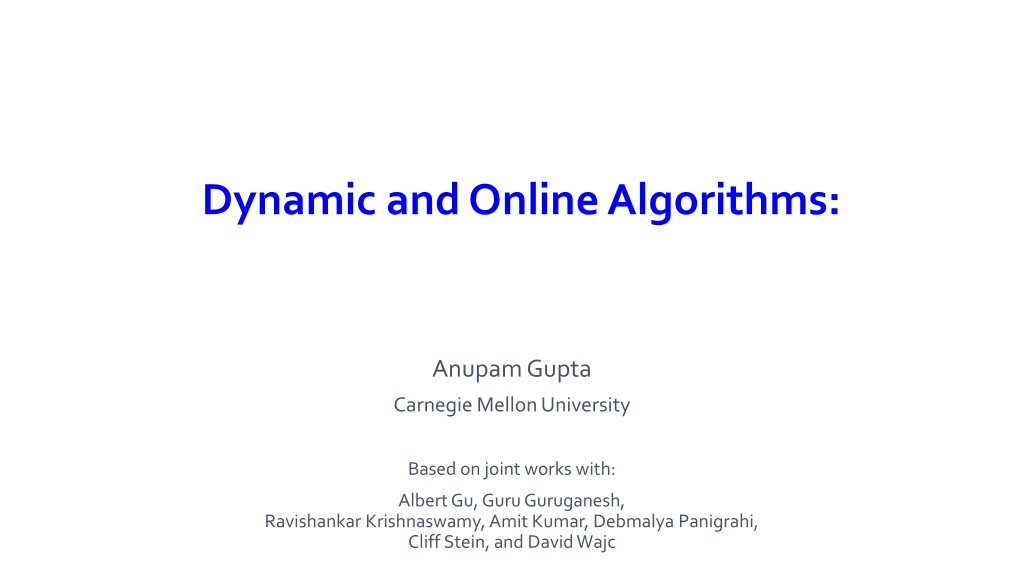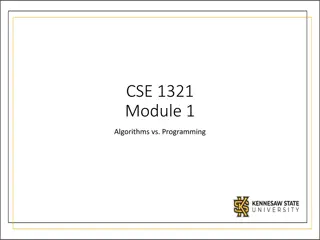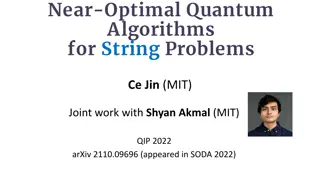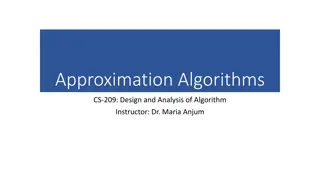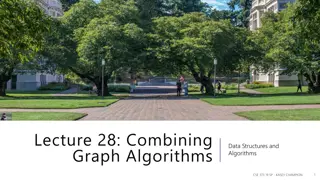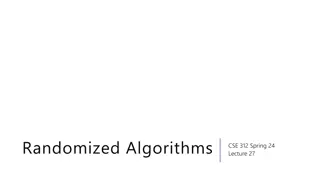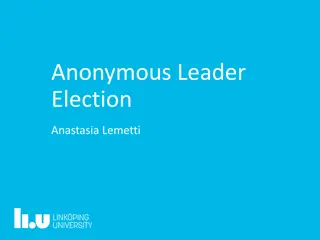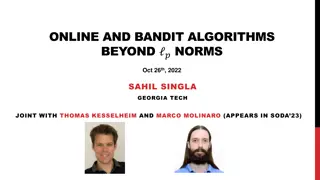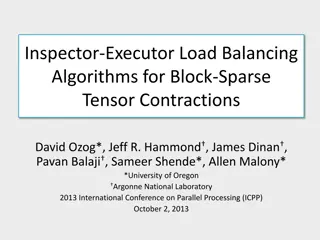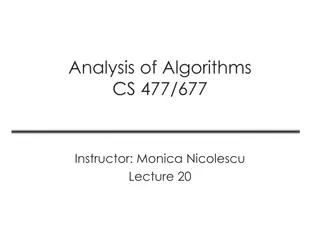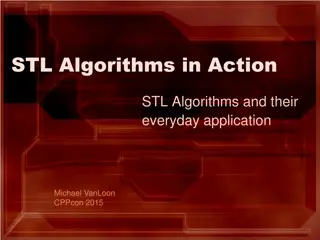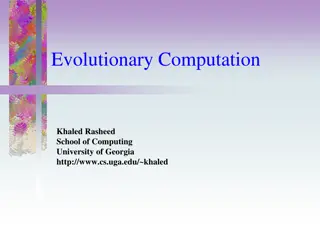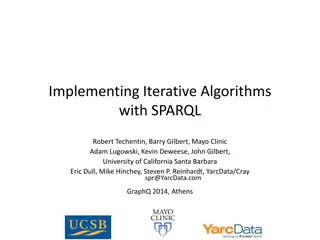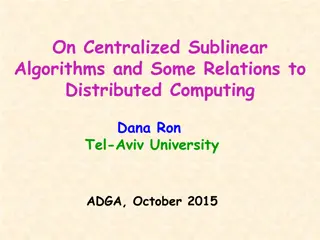Dynamic and Online Algorithms
This publication discusses dynamic and online algorithms in collaboration with researchers such as Albert Gu, Guru Guruganesh, and others. It covers topics like approximation algorithms, competitive analysis, load balancing, edge orientation, and more. The content includes insights on maintaining solutions for current inputs, maintaining irrevocable decisions, and aiming for comparable solutions with offline algorithms. Real-world problems like minimizing maximum load on machines and in-degree of vertices are explored in this study.
Download Presentation

Please find below an Image/Link to download the presentation.
The content on the website is provided AS IS for your information and personal use only. It may not be sold, licensed, or shared on other websites without obtaining consent from the author.If you encounter any issues during the download, it is possible that the publisher has removed the file from their server.
You are allowed to download the files provided on this website for personal or commercial use, subject to the condition that they are used lawfully. All files are the property of their respective owners.
The content on the website is provided AS IS for your information and personal use only. It may not be sold, licensed, or shared on other websites without obtaining consent from the author.
E N D
Presentation Transcript
Dynamic and Online Algorithms: Anupam Gupta Carnegie Mellon University Based on joint works with: Albert Gu, Guru Guruganesh, Ravishankar Krishnaswamy, Amit Kumar, Debmalya Panigrahi, Cliff Stein, and David Wajc
Dynamic (and) Online Algorithms: a little change will do you good Anupam Gupta Carnegie Mellon University Based on joint works with: Albert Gu, Guru Guruganesh, Ravishankar Krishnaswamy, Amit Kumar, Debmalya Panigrahi, Cliff Stein, and David Wajc
Dynamic Approximation Algorithms: a little change will do you good Anupam Gupta Carnegie Mellon University Based on joint works with: Albert Gu, Guru Guruganesh, Ravishankar Krishnaswamy, Amit Kumar, Debmalya Panigrahi, Cliff Stein, and David Wajc
online algorithms and competitive analysis At any time ?, maintain a solution for the current input past decisions are irrevocable solution should be comparable to the best offline algorithm which knows the input till time ?. Competitive ratio of an on-line algorithm on input ?1,?2, ,??, sup ? optimal solution cost for ?1, ,?? cost of solution produced at time ?
problem 1: load balancing At each time, a unit size job arrives can be processed by a subset of machines. Jobs already assigned cannot be reassigned to another machine. Goal: Minimize the maximum load on any machine.
problem 1: load balancing At each time, a unit size job arrives can be processed by a subset of machines. Jobs already assigned cannot be reassigned to another machine. Goal: Minimize the maximum load on any machine. Greedy has competitive ratio (log?), where m = #machines. [Azar Naor Rom 92]
problem 1b: edge orientation Edges (say, of a tree) arrive online, must orient each arriving edge. Minimize the maximum in-degree of any vertex. Special case of load balancing, where each job can go to two machines. Can make in-degree of one vertex (log?). [Azar, Naor, Rom 92]
problem 2: online spanning tree v1 v0 v3 v4 v2 Start with a single point ?0 At time ?, new point ?? arrives Distances ?(??,??) for ? < ? revealed Want: At any time ?, spanning tree on revealed points Goal: Minimize tree cost // ?(.,.) satisfy triangle ineq. Theorem: cost(Greedy tree) O(log ?) MST(?0, ,??) Matching lower bound of (log ?). [Imase Waxman 91]
problem 2: online spanning tree Theorem: cost(Greedy tree) O(log ?) MST(?0, ,??) Matching lower bound of (log ?). [Imase Waxman 91]
problem 3: set cover ?5 ?4 ?3 ?2 ?1 Given collection of ? sets At time ?, new element ?? arrives and reveals which sets it belongs to Want: At any time ?, maintain set cover on revealed elements Goal: Minimize cost of set cover. Theorem: cost(algorithm) O(log m log ?) OPT(?1, ,??) Matching lower bound on deterministic algos. [Alon Awerbuch Azar Buchbinder Naor 05]
(dynamic) online algorithms At any time ?, maintain a solution for the current input past decisions are irrevocable solution should be comparable to the best offline algorithm which knows the input till time ?. Relax this requirement. Still compare to clairvoyant OPT. Measure number of changes ( recourse ) per arrival - e.g., at most O(1) changes per arrival (worst-case) - or, at most t changes over first t arrivals (amortized) Competitive ratio of an on-line algorithm on input ?1,?2, ,??, sup ? optimal solution cost for ?1, ,?? a.k.a. dynamic (graph) algorithms: traditionally measure the update time instead of #changes, we measure recourse. traditionally focused on (exact) graph algorithms, now for appox.algos too. cost of solution produced at time ?
consider edge orientation Edges (of a tree) arrive online, a solution should orient each arriving edge. Minimize the maximum in-degree of any vertex. What if we change orientation of few edges upon each arrival?
consider edge orientation Edges (of a tree) arrive online, a solution should orient each arriving edge. Minimize the maximum in-degree of any vertex. What if we change orientation of few edges upon each arrival?
or spanning tree v3 v0 v2 v5 v4 v1 i.e., allowed to delete some old edges, pick new ones instead. trade-off between #swaps and cost of tree
a glimpse of some results v1 v0 v3 v4 ?5 ?4 ?3 ?2 ?1 v2 In-degree ?(log?) Cost ?(log?) Cost ?(log?log?) In-degree ?(1) Recourse ?(1) (amortized) Cost ?(1) Recourse ? 1 (worst-case) Cost ? log? Recourse O(1) (amortized) extend to load-balancing and single-sink flows extend to fully-dynamic O(1) amortized extend to fully-dynamic O(1) amortized
a glimpse of some results v1 v0 v3 v4 ?5 ?4 ?3 ?2 ?1 v2 In-degree ?(log?) Cost ?(log?) Cost ?(log?log?) In-degree ?(1) Recourse ?(1) (amortized) Cost ?(1) Recourse ? 1 (worst-case) Cost ? log? Recourse O(1) (amortized) extend to load-balancing and single-sink flows extend to fully-dynamic O(1) amortized extend to fully-dynamic O(1) amortized
consider edge orientation Recourse vs in-degree trade-off: Competitive ratio No. of re-orientations 1 ? Na ve log? 0 Greedy [Brodal and Fagerberg 98] 2 3 (amortized) Amortized: after ? edge insertions, at most 3? edge reorientations.
the Brodal-Fagerberg algorithm When a new edge arrives, orient it arbitrarily. If the in-degree of a vertex becomes 3, flip all the incoming edges.
the Brodal-Fagerberg algorithm When a new edge arrives, orient it arbitrarily. If the in-degree of a vertex becomes 3, flip all the incoming edges. Could lead to cascade of edge flips. In fact, a single edge addition could cause ? edge flips!
analysis Algorithm Optimal (has in-degree 1) Theorem: total number of flips till time ? is at most 3?. bad edge = oriented oppositely from the optimal tree. (?) : number of bad edges at time ? When a new edge arrives, (?) may increase by 1. What happens to (?) when we flip three 3 incoming edges for some vertex? (?) must decrease by at least 1 ! Total increase in is ?, so total decrease ?.
open problems and extensions Recourse vs in-degree trade-off: Competitive ratio No. of re-orientations 1 ? Na ve log? 0 Greedy [Brodal and Fagerberg 98] 2 3 (amortized) Extensions: Theorem: O(1)-competitive load balancing with O(1) amortized recourse Theorem: O(1)-competitive single-sink flows with O(1) amortized recourse Open: get a O(1) competitive algorithm with O(1) re-orientations worst-case. Open: get a O(1) competitive algorithm with O(1) re-orientations (even amortized) for fully-dynamic case.
a glimpse of some results v1 v0 v3 v4 ?5 ?4 ?3 ?2 ?1 v2 In-degree ?(log?) Cost ?(log?) Cost ?(log?log?) In-degree ?(1) Recourse ?(1) (amortized) Cost ?(1) Recourse ? 1 (worst-case) Cost ? log? Recourse O(1) (amortized) extend to load-balancing and single-sink flows extend to fully-dynamic O(1) amortized extend to fully-dynamic O(1) amortized
online spanning tree (with recourse) Recourse: when new request vertex ?? arrives, 1) add edge connecting ?? to some previous vertex 2) possibly swap some existing tree edges with non-tree edges Let ?? be tree after ? arrivals. v3 v0 v2 v5 v4 v1
results Competitive ratio No. of reassignments log? 0 Greedy 1 ? Trivial ? (amortized) Imase, Waxman 91 2 1 + ? 1/? log1/? (amortized) Megow et al. 12 1 + ? 1/? Gu, G., Kumar 13 (amortized) Gu, G., Kumar 13 O(1) 1
results Competitive ratio No. of reassignments log? 0 Greedy 1 ? Trivial ? (amortized) Imase, Waxman 91 2 1 + ? 1/? log1/? (amortized) Megow et al. 12 1 + ? 1/? Gu, G., Kumar 13 (amortized) Gu, G., Kumar 13 O(1) 1
algorithm idea (Greedy) When a new vertex arrives, it connects to the closest vertex in the tree. Repeat If there are edges ? ?,? ? such that ? lies in the cycle formed by ? + ? ?? ?? then swap ?,? Leads to MST, but may incur too many swaps.
algorithm idea (Greedy) When a new vertex arrives, it connects to the closest vertex in the tree. Repeat If there are edges ? ?,? ? such that ? lies in the cycle formed by ? + ? ?? ??/(1 + ?) then swap ?,? Leads to 1 + ? -approximate MST, with ? ? amortized recourse. 1
analysis MST
analysis 1 2 MST 4 8 7 5 6 3 Greedy 0
analysis 1 2 MST 4 8 7 5 6 3 Greedy 0 Product of lengths of red greedy edges 4n Goal: Product of lengths of blue edges (no matter what order the vertices arrive) Each swap some edge length decreases by (1+ ) number of swaps is log1 + 4n = O(n/ ) [Gu, also Abraham Bartal Neiman Schulman]
analysis 1 2 MST 4 8 7 5 e 6 3 Greedy 0 Product of lengths of red greedy edges ?? 1 ?2 4n Goal: Product of lengths of blue edges Exists e on this path P such that len(P)/ len(e) small len(first greedy edge)/ len(e)
analysis 1 MST ?? nodes e ?? nodes Greedy 0 Product of lengths of red greedy edges ?? 1 ?2 Goal: Product of lengths of blue edges 2 ?? ?2 2 ? ?? Exists e on this path P such that len(P)/ len(e) small len(first greedy edge)/ len(e)
analysis 1 MST ?? nodes e ?? nodes Greedy 0 Product of lengths of red greedy edges ?? 1 ?2 Goal: Product of lengths of blue edges 2 ?? ?2 2 ? ?? len(first greedy edge)/ len(e) Induction on the two subtrees: ??? 1 ?? ??? 1 ?? Product(greedy)/product(blue) 2 2
analysis 1 MST ?? nodes e ?? nodes Greedy 0 2 ?? ?2 2 ? ?? New Goal: Exists e on this path P such that len(P)/ len(e)
analysis 1 MST e Greedy 0 ?2 2 ?? New Goal: Exists e on this path P such that len(e)/ len(P) 2 ? ?? Suppose not: ?2 2 ?? 4 4 2 ?2/6 ? e in P 1 = e in P len(e)/len(P) e in P < 1 2,?? 2) 2 ? min(?? ? ?? contradiction for C large!
results Competitive ratio No. of reassignments log? 0 Greedy 1 ? Trivial ? (amortized) Imase, Waxman 91 2 1 + ? 1/? log1/? (amortized) Megow et al. 12 1 + ? 1/? Gu, G., Kumar 13 (amortized) Gu, G., Kumar 13 O(1) 1
extensions Allow vertex deletions too (fully-dynamic model). [G., Kumar 14] Theorem: O(1)-competitive algorithm with O(1)-amortized swaps. Theorem: non-amortized O(1)-swaps if we allow deletions only. Theorem: ?( ?)-update time dynamic graph algorithms. [ acki Pilipczuk Sankowski Zych 15]
road-map v1 v0 v3 v4 ?5 ?4 ?3 ?2 ?1 v2 In-degree ?(log?) Cost ?(log?) Cost ?(log?log?) In-degree ?(1) Recourse ?(1) (amortized) Cost ?(1) Recourse ? 1 (worst-case) Cost ? log? Recourse O(1) (amortized) extend to load-balancing and single-sink flows extend to fully-dynamic O(1) amortized extend to fully-dynamic O(1) amortized
online set cover ?5 ?4 ?3 ?2 ?1 Given a collection of m sets Elements arrive online. Element ?? announces which sets it belongs to. Pick some set to cover element if yet uncovered. Minimize cost of sets picked. Today: Allow recourse. Assume unit costs. Get O(log n) competitive with O(log n) recourse.
offline: the greedy algorithm Solution (a) picks some sets (b) assigns every element to some picked set. Greedy: Iteratively pick set S with most yet-uncovered elements, assign them to S (1 + ln n)-approx. very robust: if current-best set covers ? uncovered elements, pick some set covering (?) elements lose only ?(1) factor.
online: the greedy algorithm density = 3 density = 2 density = 2 density = 1 Universe of current points
online: the greedy algorithm density = 3 density = 2 density = 2 density = 1 ?4 ?7 ?1 ?2 ?5 ?3 ?8 ?6
online: the greedy algorithm ?6 density = 1 ?4 ?7 ?3 ?8 density = 2 ?1 ?2 ?5 density [3,4] density [5,8]
online: the greedy algorithm ?6 density = 1 ?4 ?7 ?3 ?8 density = 2 ?1 ?2 ?5 density [3,4] density [5,8] Unstable set S: set that contains (2? 1,2?] elements, all currently being covered at densities 2? 1. E.g., suppose some set contains ?3,?4 and ?6. Then it is unstable. Lemma: no unstable sets solution is O(log n)-approximate.
online: the greedy algorithm ?3 ?6 ?9 ?9 ?6 density = 1 ?4 ?7 ?3 ?8 density = 2 ?1 ?2 ?5 density [3,4] density [5,8] Suppose ?9 arrives. Cover it with any set containing it. Now green set is unstable. So add it in, and assign ?3,?6,?9 to it. Clean up, resettle sets at the right level.
overview of the analysis Invariant: element at level 2? has 2(log? ?) tokens When a new element arrives and not covered by current sets, pick any set that covers it, add it with density 1 Start each element with 2log? tokens If some unstable set exists, add it to the correct level, assign those elements to it. Elements moving down lose 2 tokens use 1 to pay for new set May cause other sets to lose elements, become lighter. They float up to the correct level. Sets moving up lose of their elements use their other token to pay for rising up* Cause other sets to become unstable, etc. Claim: system stabilizes. Also, O(log n) changes per arrival, amortized. *minor cheating here.
road-map v1 v0 v3 v4 ?5 ?4 ?3 ?2 ?1 v2 In-degree ?(log?) Cost ?(log?) Cost ?(log?log?) In-degree ?(1) Recourse ?(1) (amortized) Cost ?(1) Recourse ? 1 (worst-case) Cost ? log? Recourse O(1) (amortized) extend to load-balancing and single-sink flows extend to fully-dynamic O(1) amortized extend to fully-dynamic O(1) amortized get fully-dynamic polylog(n) update times too
other problems considered in this model Online Bin-packing, Bin-covering [Jansen et al. 14] [G. Guruganesh Kumar Wajc 17] Makespan Minimization on parallel/related machines on unrelated machines [Andrews Goemans Zhang 01] [G. Kumar Stein 13] Traveling Salesman Problem (TSP) [Megow Skutella Verschae Wiese 12] Facility Location Problem [Fotakis 06, 07] Tree Coloring [Das Choudhury Kumar 16]
so in summary For combinatorial optimization problems online, allowing bounded recourse can improve the competitive ratio qualitatively. Many open problems: specific problems like Steiner forest, or fully-dynamic matchings understanding lower bounds connections to dynamic algorithms (and lower bounds) other models for ensuring solutions are Lipschitz?
